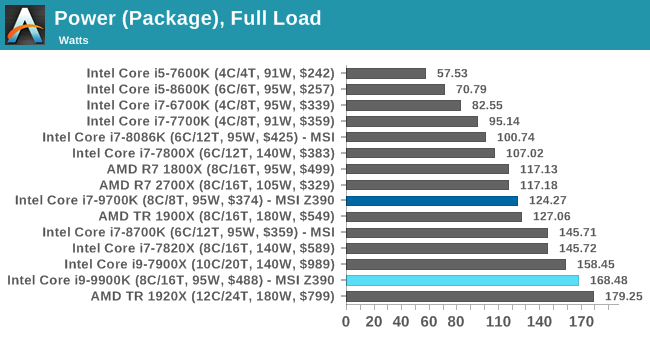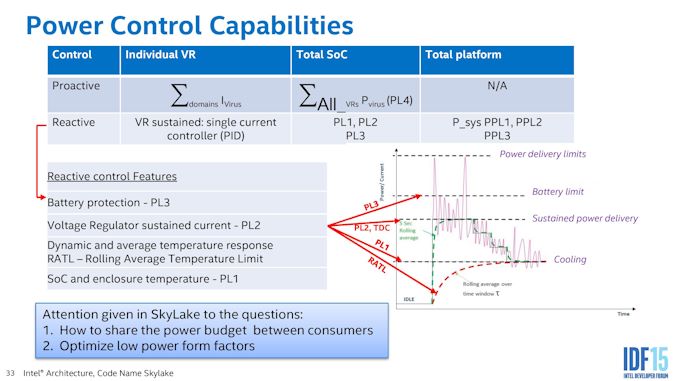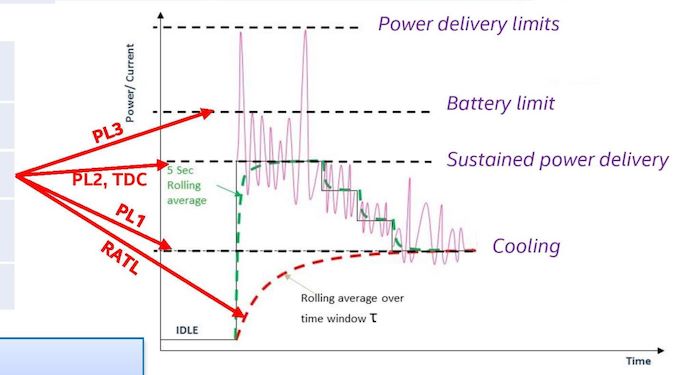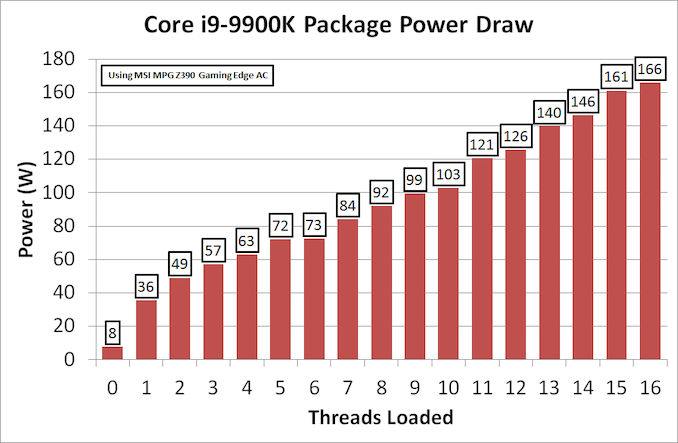The Intel 9th Gen Review: Core i9-9900K, Core i7-9700K and Core i5-9600K Tested
by Ian Cutress on October 19, 2018 9:00 AM EST- Posted in
- CPUs
- Intel
- Coffee Lake
- 14++
- Core 9th Gen
- Core-S
- i9-9900K
- i7-9700K
- i5-9600K
Power Consumption
TDP or not the TDP, That is The Question
Notice: When we initially posted this page, we ran numbers with an ASRock Z370 board. We have since discovered that the voltage applied by the board was super high, beyond normal expectations. We have since re-run the numbers using the MSI MPG Z390 Gaming Edge AC motherboard, which does not have this issue.
As shown above, Intel has given each of these processors a Thermal Design Power of 95 Watts. This magic value, as mainstream processors have grown in the last two years, has been at the center of a number of irate users.
By Intel’s own definitions, the TDP is an indicator of the cooling performance required for a processor to maintain its base frequency. In this case, if a user can only cool 95W, they can expect to realistically get only 3.6 GHz on a shiny new Core i9-9900K. That magic TDP value does not take into account any turbo values, even if the all-core turbo (such as 4.7 GHz in this case) is way above that 95W rating.
In order to make sense of this, Intel uses a series of variables called Power Levels: PL1, PL2, and PL3.
That slide is a bit dense, so we should focus on the graph on the right. This is a graph of power against time.
Here we have four horizontal lines from bottom to top: cooling limit (PL1), sustained power delivery (PL2), battery limit (PL3), and power delivery limit.
The bottom line, the cooling limit, is effectively the TDP value. Here the power (and frequency) is limited by the cooling at hand. It is the lowest sustainable frequency for the cooling, so for the most part TDP = PL1. This is our ‘95W’ value.
The PL2 value, or sustained power delivery, is what amounts to the turbo. This is the maximum sustainable power that the processor can take until we start to hit thermal issues. When a chip goes into a turbo mode, sometimes briefly, this is the part that is relied upon. The value of PL2 can be set by the system manufacturer, however Intel has its own recommended PL2 values.
In this case, for the new 9th Generation Core processors, Intel has set the PL2 value to 210W. This is essentially the power required to hit the peak turbo on all cores, such as 4.7 GHz on the eight-core Core i9-9900K. So users can completely forget the 95W TDP when it comes to cooling. If a user wants those peak frequencies, it’s time to invest in something capable and serious.
Luckily, we can confirm all this in our power testing.
For our testing, we use POV-Ray as our load generator then take the register values for CPU power. This software method, for most platforms, includes the power split between the cores, the DRAM, and the package power. Most users cite this method as not being fully accurate, however compared to system testing it provides a good number without losses, and it forms the basis of the power values used inside the processor for its various functions.
Starting with the easy one, maximum CPU power draw.

Focusing on the new Intel CPUs we have tested, both of them go beyond the TDP value, but do not hit PL2. At this level, the CPU is running all cores and threads at the all-core turbo frequency. Both 168.48W for the i9-9900K and 124.27W for the i7=9700K is far and above that ‘TDP’ rating noted above.
Should users be interested, in our testing at 4C/4T and 3.0 GHz, the Core i9-9900K only hit 23W power. Doubling the cores and adding another 50%+ to the frequency causes an almost 7x increase in power consumption. When Intel starts pushing those frequencies, it needs a lot of juice.
If we break out the 9900K into how much power is consumed as we load up the threads, the results look very linear.
This is as we load two threads onto one core at a time. The processor slowly adds power to the cores when threads are assigned.
Comparing to the other two ‘95W’ processors, we can see that the Core i9-9900K pushes more power as more cores are loaded. Despite Intel officially giving all three the same TDP at 95W, and the same PL2 at 210W, there are clear differences due to the fixed turbo tables embedded in each BIOS.
So is TDP Pointless? Yes, But There is a Solution
If you believe that TDP is the peak power draw of the processor under default scenarios, then yes, TDP is pointless, and technically it has been for generations. However under the miasma of a decade of quad core processors, most parts didn’t even reach the TDP rating even under full load – it wasn’t until we started getting higher core count parts, at the same or higher frequency, where it started becoming an issue.
But fear not, there is a solution. Or at least I want to offer one to both Intel and AMD, to see if they will take me up on the offer. The solution here is to offer two TDP ratings: a TDP and a TDP-Peak. In Intel lingo, this is PL1 and PL2, but basically the TDP-Peak takes into account the ‘all-core’ turbo. It doesn’t have to be covered under warranty (because as of right now, turbo is not), but it should be an indication for the nature of the cooling that a user needs to purchase if they want the best performance. Otherwise it’s a case of fumbling in the dark.














274 Comments
View All Comments
AutomaticTaco - Saturday, October 20, 2018 - link
Revised. TDP is still some generic average not true max. Regardless, not 220w.https://www.anandtech.com/show/13400/intel-9th-gen...
The motherboard in question was using an insane 1.47v
https://twitter.com/IanCutress/status/105342741705...
https://twitter.com/IanCutress/status/105339755111...
dezonio2 - Friday, October 19, 2018 - link
I would love to see overclocking performance of the 9600k. It would show exactly how much of a difference the upgraded TIM makes if compared to 8600k.emn13 - Friday, October 19, 2018 - link
That power consumption seems pretty crazy. Going from 4.5 to 5Gz for +56% powerdraw? or worse, from 5.0 to 5.3GHz for 6% clock boost and +40% powerdraw?This proc looks like it makes sense at 4.5GHz; beyond that - not much. I mean going from 4.5 to 5.3 isn't nothing - 18% more clocks! But that's going to translate into less-than-that performance gain, and even 18%, while admirable and all, is often not actually all that noticeable - unlike that powerdraw, which you'll likely notice in terms of noise and effort to get the system cooled at all.
I don't know; this proc looks... cool... but borderline. I'm not sure I'd buy it, even if money were no object (and since I'd consider this for work - it basically isn't).
Tkan2155 - Saturday, October 20, 2018 - link
Yes bill add up this prepare big wallet . amd can overclock higher but it's better at stock . intel is going over limit because they want to show the world they are the bestmapesdhs - Sunday, October 21, 2018 - link
But then, the candle that burns twice as brightly burns half as long. :)MonkeyPaw - Friday, October 19, 2018 - link
In regards to TDP, I say use your own methodology and ratings if Intel and AMD can’t arrive at a standard measure. Based on how the i9 truly performs in this regard, the 95W rating is just shy of disingenuous. When real world values are applied it does change where this CPU sits in regard to its overall value. Lots of performance? Yes, but it comes at a significant cost. These CPUs aren’t like GPUs, where the cooling solution is designed to match the limits of the GPU. No, Intel doesn’t even bundle a cooler, because they know they have nothing to offer to hit boost speeds, and let’s be real—it’s the boost speeds that help sell this product and yield bragging rights.pavag - Friday, October 19, 2018 - link
It doesn't have a price/performance chart, so it is hard to tell how justifiable is to spend on this processor, compared to alternatives, and that's the main purpose of reading this kind of articles.Here is one from TomsHardware, for reference:
https://img.purch.com/r/711x457/aHR0cDovL21lZGlhLm...
It makes clear that is little to gain from a cheap i5-8400 to an i9-9900K, and it also tells which processors are better performing at a given price, or cheaper at a given performance. At least from an average FPS gaming viewpoint.
WinterCharm - Friday, October 19, 2018 - link
Well written. Great article, and I enjoyed it thoroughly :)Machinus - Friday, October 19, 2018 - link
Can you test the power draw and temperatures of the 9900 with HT disabled, and compare that to the 9700 under the same conditions?Felice - Saturday, October 20, 2018 - link
Ryan--Any chance of you doing the same run with the 9900K's hyperthreading disabled? A lot of gamers find they get better performance without hyperthreading.